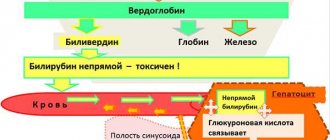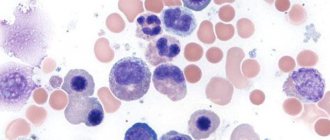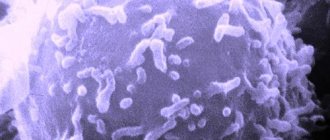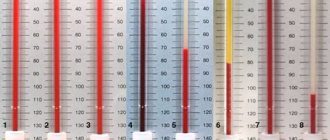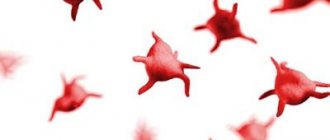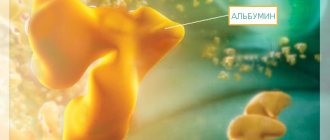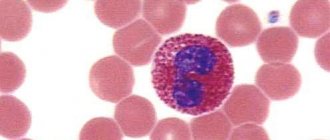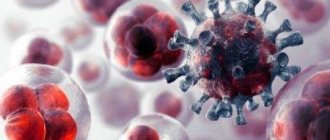In what cases is a CPK test prescribed?
This examination is used to diagnose cardiac pathologies and skeletal muscle diseases. Using CPK in the blood, the causes of pain in the chest area are determined and a heart attack is diagnosed, as well as how damaged the heart muscle is. A biochemical blood test for CPK is carried out for the purpose of early diagnosis of myocardial infarction, dermatomyositis, muscle dystrophy, and inflammatory processes. In addition, the analysis is prescribed to evaluate the effectiveness of treatment for a heart attack.
Features of the analysis
The molecule of creatine phosphokinase is complex. It consists of two dimers: B and M. Certain isoenzymes accumulate in different organs, namely:
- In skeletal muscles - MM.
- In the brain - VV.
- In the heart muscle - CF.
The activity of CK is determined by a set of isoenzymes that enter the blood when the muscle tissue of the skeleton and heart is damaged. Due to the high information content of the study, it can be prescribed by different specialists: cardiologist, oncologist, endocrinologist, neurologist or therapist.
The analysis is a rather complex procedure, therefore, most often, it is carried out in a hospital setting, where there are more equipped laboratories, the equipment of which allows them to provide accurate data.
A special feature of the study is that it can be used to diagnose myocardial infarction in the first 6 hours of pathology development. 30 hours after a heart attack, CPK levels return to normal.
A multiple increase in the amount of creatine phosphokinase in the blood can occur during heavy physical exertion, muscle injury, or poisoning. In this regard, this biochemical analysis is an important additional tool for confirming or refuting suspicions of the development of a certain pathology.
The purpose of this analysis always has good reasons. Typically this happens in the following cases:
- When there is a need to diagnose the development of myocardial infarction at the initial stages and it is necessary to monitor its dynamics.
- If it is necessary to clarify the diagnosis for serious diseases of the skeletal muscles.
- After serious injury to muscle tissue, in order to determine the extent of the damage.
- If you suspect cancer or are undergoing treatment for tumors.
The analysis is necessarily indicated for patients who are being treated in a cardiology hospital. This allows you to monitor the condition of the heart muscle and, if necessary, adjust the treatment measures.
The study is aimed at detecting an increase in the amount of creatine phosphokinase in the blood. If there is a certain tendency towards an increase in indicators, then it is quite possible to talk about an existing threat to the heart muscle.
A blood test for CPK is carried out if the doctor, based on the patient’s complaints, has good reason to believe that a serious pathology is occurring:
- hearts;
- brain;
- muscles;
- heart vessels.
It is very important to understand what blood CPK shows, and which indicators are not critical, and which indicate serious pathologies. Of course, a jump in the level of this enzyme does not always mean a disease, but such a deviation still cannot be ignored.
Thus, a doctor may prescribe a blood test for creatine phosphokinase if there is a suspicion that the patient suffers from:
- pre-infarction condition or developed myocardial infarction (CPK MB study is prescribed);
- dermatomyositis;
- dystrophy of muscular tissues;
- the presence of inflammatory processes in muscle tissue;
- polymyositis;
- myositis of viral etiology;
- muscle injuries;
- disruption of GM operation;
- pre-stroke condition or stroke;
- rheumatic carditis;
- arrhythmias;
- TBI;
- too intense physical activity;
- the use of injectable drugs injected directly into the heart muscle;
- frequent attacks of tachycardia, etc.
Also, an analysis for the content of creatine phosphokinase in the blood is carried out to monitor the patient’s condition in the postoperative period (if there has been surgery on the heart, brain due to TBI or other injuries, as well as in the muscle area).
How is it carried out?
To determine the activity of CPK in biological fluids, a set of reagents is used
Blood is taken for CPK in the morning on an empty stomach from a vein in the elbow area. Then the material is sent to the laboratory for testing, where it is separated into serum and a fraction with cells. The level of creatine kinase is measured in U (unit of enzyme activity) per 1 liter of serum. To clarify the diagnosis, repeat blood donation is prescribed after two to three days.
Creatine kinase (CPK): normal level in the blood, reasons for the increase, role in diagnosis
Content:
When tests are taken from a patient brought by an ambulance with suspected acute myocardial infarction, among the long list of indicators of interest to the doctor, there will most likely be a study such as creatine kinase activity. Usually, health workers, fussing around a seriously ill patient, often repeat an abbreviation that only they understand - KFK. But this is creatine kinase, or, as they used to call it, creatine phosphokinase (CPK).
Determination of creatine kinase activity is of great importance in clinical laboratory diagnostics - in acute myocardial infarction, almost all patients experience a natural and pronounced increase in the activity of total creatine kinase (mainly due to the MB fraction, which is also determined if possible, but at first they only guess about it).
Creatine kinase, creatine phosphokinase and isoenzyme fractions
Creatine kinase is an enzyme that participates in the energy metabolism of tissues, acting as a catalyst for important biochemical transformations, in particular, it accelerates the process of phosphorylation of creatine so that the latter can provide the energy basis for muscle contraction.
Most of the enzyme is concentrated in skeletal muscles, heart muscle, smooth muscle fibers of the uterus and nervous tissue of the brain.
The activity of CPK suppresses the thyroid hormone - thyroxine.
The two dimers of creatine kinase (B and M), which make up the enzyme molecule, form combinations (isoenzymes), and although each of the resulting isoenzymes finds a place in different tissues, some are preferred, so the isoenzymes differ in their belonging to one or another organ :
- MM is a muscle isoenzyme, with a predominant localization in skeletal muscles (CK-MM) - its share in the blood plasma accounts for up to 98% of all creatine kinase activity;
- BB - brain isoenzyme, preferential localization is obvious (CC-BB) - is not detected in plasma or serum, since it does not cross the blood-brain barrier (appears in the blood during severe TBI or stroke);
- MB is a hybrid isoenzyme (CK-MB), it prefers the heart muscle, where it is found in large quantities; in serum (plasma) its share is about 2% of the total (total) creatine kinase activity.
Thus, in a laboratory study of the total activity of the enzyme, which we habitually continue to call CPK, we mean the activity of each of the isoenzymes released into the blood from the heart muscle (2%) and skeletal muscle (98%).
Standards for adults and children
The activity of creatine kinase is naturally higher in children, because they grow and develop intensively, all their processes are accelerated. In addition, the activity of the enzyme depends on gender (in men it is higher), physique (the more pumped up muscles, the higher the activity of the enzyme) and physical activity (in people who keep their body in good shape, CPK increases). However, the values of creatine kinase depending on gender, age and other factors can be judged based on the table:
Gender, ageNormal, U/l (U/l), at 37°C
| Children up to 5 days of life from 5 days to six months from 6 to 12 months | up to 652 up to 295 up to 203 |
| Children from one to three years old from 3 to 6 years old | up to 228 up to 149 |
| Children from 6 to 12 years old boys girls | up to 247 up to 154 |
| Boys, young men from 12 to 17 years old Boys, men over 17 years old | up to 270 up to 195 |
| Girls, girls from 12 to 17 years old Girls, women over 17 years old | up to 123 up to 167 |
A decrease in enzyme activity does not have any diagnostic value, therefore the norms are given only in upper limit values.
Unless CK activity approaches zero will indicate a sedentary lifestyle or increased activity of the thyroid gland. Blood to study creatine kinase activity is taken in the same way as for other biochemical tests: on an empty stomach, excluding smoking (an hour before) and reducing the intensity of physical and emotional stress (in general, everything is as always).
The significance of creatine kinase in the diagnostic search
Creatine kinase begins to enter the blood in large quantities when the cells containing it are damaged. Most often this occurs when cardiomyocytes and skeletal muscle cells are damaged, which is why CK activity is so important in diagnosing acute myocardial infarction.
In addition, this laboratory test provides significant assistance in monitoring the course of the disease. Due to the fact that the activity of creatine kinase during myocardial infarction is significantly increased already in the first hours of the disease, CK is recognized as an early marker of MI. This laboratory test does not escape erased forms of the disease, as well as repeated heart attacks, when the ECG is not particularly helpful.
By the way, there is another biochemical test that reacts to damage to cardiac muscle cells very early, this is myoglobin, its increased level can be observed even earlier than CC.
Since the total activity of CK can come from different tissues, its role for the diagnosis of MI is not as significant as the importance of determining its isoenzyme - the MB fraction, the increase in activity of which during myocardial infarction is most specific (the share of CK-MB is 5% or more of the total activity creatine kinase).
Isoenzyme spectrum of creatine kinase – MB-fraction
It is difficult to overestimate the importance of such a laboratory indicator as the CK-MB isoenzyme or MB fraction. The activity of total creatine kinase is, of course, a very informative analysis, but it consists of an increase in the activity of other isoenzymes, that is, with a high degree of probability one can assert the presence of a heart attack, but complete conviction that this is an MI will only be given by the activity (or content) MV fractions.
Normally, the values of this indicator cannot exceed 10 U/l (content less than 10 mg/l), or rather, they should be lower. But the thing is that not all laboratories have a test kit for QC-MV, for example, in a district hospital that does not have a specialized department (cardiology), it is simply impractical to keep reagents, and even more so in a clinic. This analysis is performed on patients with a heart attack, and the ambulance strives to deliver a person with suspected acute cardiac pathology to a cardiology clinic or department as quickly as possible.
Increased activity of the MV fraction:
- In case of myocardial infarction: growth begins 4–6 hours after the attack, the maximum is observed after 18–30 hours, returning to normal (if all is well) on the 3rd day;
- With a hereditary neuromuscular pathology called Duchenne cardiomyodystrophy, which occurs with progressive damage to the striated muscles.
The study of the cardiac muscle creatine kinase isoenzyme is valuable not only for diagnosing myocardial damage; CC-MB plays a significant role in terms of monitoring the patient’s condition.
Behavior of enzymes during myocardial infarction
It should be noted that during myocardial infarction, in addition to creatine kinase, increased values of the activity of other enzymes related to the heart muscle (AST, LDH, aldolase) are observed, but their dynamics are less characteristic (data in the table).
Enzyme Beginning of increase in activity, hours Maximum increase in activity, hours Return to normal, days Expected increase, times
| Creatine kinase | 2 — 4 | 18 — 30 | 3 — 6 | 3 — 30 |
| ASAT | 4 — 6 | 24 — 48 | 4 — 7 | 4 — 12 |
| LDH (total) | 8 — 10 | 48 — 72 | 8 — 9 | 2 — 4 |
| Aldolaza | 4 — 6 | 24 — 48 | 2 — 9 | 2 — 5 |
The table shows that within 2–4 hours after the onset of pain, the activity of creatine kinase begins to increase.
By the end of the first day of illness, creatine kinase activity can be increased from 3 to 30 times. Meanwhile, the half-life of CK in the bloodstream is relatively short, so you can soon see normal values of CPK activity.
A repeated increase in the enzyme after its decrease (in the presence of corresponding symptoms) gives reason to believe that the patient has had a new heart attack, which on the ECG is often disguised as the first. However, a repeated increase may indicate the development (in addition to MI) of myocarditis or pericarditis.
In this regard, CK activity is determined every 4 - 6 hours during the first 2 days (48 hours) of the disease and that is why doctors so often pronounce an incomprehensible abbreviation (KFK). If everything goes well in the first two days, the enzyme activity continues to be determined, but only once a day, not forgetting that the most specific indicator is CK-MB.
graph of the activity of the CF fraction of CPK (green) and other markers for diagnosing MI
Long-term persistence of elevated creatine phosphokinase values in terms of prognosis is considered not a very encouraging sign.
The increase in lactate dehydrogenase (LDH) activity does not occur as rapidly as creatine kinase, but it persists for a longer time, which makes it possible to make a diagnosis when the myocardial infarction has “aged” for several days.
The dynamics of aspartate aminotransferase activity during myocardial infarction occupies an intermediate position between the activity of creatine kinase and lactate dehydrogenase. However, this indicator is also studied and is considered important when myocardial damage is suspected.
And many more diseases...
In addition to myocardial infarction, for which creatine phosphokinase is an early marker of damage to the heart muscle (increases 10–30 times in the first hours and reaches a maximum after 20–30 hours), an increase in enzyme activity is observed in a number of other pathological conditions:
- All types of muscular dystrophies;
- Polymyositis, viral myositis;
- Traumatic damage to the muscular system (long-term compression syndrome or crash syndrome);
- Extensive surgical operations (postoperative period);
- A state of skeletal muscle hypermetabolism called malignant hyperthermia (acute fulminant state). This pathology develops during general anesthesia for surgery and can pose a threat to the patient’s life;
- Traumatic brain injuries, brain contusion;
- Vascular pathology of the brain;
- Stroke (cerebrovascular ischemia);
- Rheumatic carditis;
- Rhythm disturbances in heart failure (congestive);
- PE (increased creatine kinase activity is observed relatively rarely);
- Damage to the heart muscle due to hypoxia (shock, hyperthermia);
- Significant load on the muscular system (running, strength sports, professional activities);
- Injections of certain medications into the muscle (narcotics, non-narcotic analgesics, certain antibiotics, sedatives and psychotropics);
- Raynaud's phenomenon;
- Strychnine poisoning;
- Impaired blood circulation and trophism, leading to the development of necrosis (bedsores) - problems for weakened bedridden patients;
- Skeletal muscle spasms;
- Acute alcohol intoxication;
- Mental pathology (epilepsy, manic-depressive syndrome, schizophrenia);
- Exposure to radioactive radiation with the development of acute radiation sickness;
- Pathology of the thyroid gland with a decrease in its function (hypothyroidism);
- Malignant neoplasms localized in the uterus, intestines, bladder and other organs.
Considering that thyroxine (thyroid hormone) inhibits the activity of creatine kinase, in patients with thyroid pathology with decreased function, the activity of the enzyme can increase up to 50 times, while the increased work of the thyroid gland, on the contrary, reduces the activity of CPK.
Creatine kinase does not increase during angina pectoris and this enzyme practically does not react to the suffering of the liver and lungs, even if the cells of these organs, for some reason other than malignant tumors, begin to rapidly deteriorate.
Video: doctor about creatine kinase
Display all posts with the tag:
Go to section:
- Blood diseases, tests, lymphatic system
Step 1: pay for the consultation using the form → Step 2: after payment, ask your question in the form below ↓ Step 3: You can additionally thank the specialist with another payment for an arbitrary amount ↑
sosudinfo.ru
How to prepare?
We also recommend reading: Biochemistry of blood and its norm
There is no need for special preparation before taking the CPK test. The patient is warned not to drink alcohol or take certain medications the day before. These drugs include statins, which are used to lower cholesterol levels. If you are taking such medications, you should inform your doctor. If the goal is to study skeletal muscles, it is not recommended to perform physical work during the day before the analysis. All this can lead to an increase in the enzyme in the blood.
Norm
In medical practice, the parameters of the norms are used, which the result of the CPK analysis . The presence of deviations indicates exhaustion of the body or the development of diseases. For an adult, results ranging from 20 to 200 U/l are considered normal.
Significant deviations from the norm are the reason for a comprehensive examination. For men, the maximum value is 167 U/l. Women whose test result is between 190 and 200 U/l are at risk.
Video: Creatine kinase - what is it?
In childhood, the norms are a little blurry , since indicators can change greatly as the child grows. Immediately after birth, the levels reach 600 U/l. Up to six months, the indicators drop to 300 U/l.
At the age of six months to a year, the normal value is 203 U/l. Then, up to three years, an increase in creatine phosphokinase to 228 U/l can be observed. Starting from three years, the level of the substance decreases to 149 U/l. From the age of six, indicators begin to depend on the child’s gender. In women, the norm can reach 247 U/l, and in boys it should not exceed 154 U/l.
Decoding
The interpretation of the analysis is carried out by the attending physician. If the total enzyme content is elevated, this may indicate strain or damage to skeletal or cardiac muscles, as well as brain tissue. Specific damage is judged by the content of specific enzymes, such as CPK-BB, CPK-MB. To clarify the diagnosis of heart disease, creatine kinase fractions are determined. The study can evaluate the level of the creatine kinase-MB isoenzyme, as well as the content of troponin, which is involved in the contraction of skeletal and cardiac muscles. In case of suspected myocardial infarction, indicators such as the nature and rate of change in CPK levels are important.
If the content of creatine kinase-MB is elevated, this may indicate muscle wasting, hypothyroidism, or lung disease (McLeod syndrome). A decrease in CPK-MB levels may be associated with rheumatoid arthritis, as well as liver dysfunction, which occurs with alcoholism.
What does an increase in creatine phosphokinase mean?
When interpreting the analysis, such a deviation from the norm may mean that the cells containing the enzyme are destroyed, and as a result, CPK is released into the blood. To exclude unreliable results due to improper preparation for the analysis, it is prescribed again after 2-3 days.
If the results are again significantly higher than normal, probable causes include:
- consequences of injuries with serious muscle damage;
- schizophrenia or epilepsy;
- cancerous tumors;
- myocardial damage as a result of a heart attack;
- weak thyroid function;
- physical overloads that cause muscle fiber ruptures;
- taking medications that affect the biochemical composition of the blood and the condition of the muscles;
- weak heart function;
- meningitis;
- diseases of the gastrointestinal tract:
- inflammation and tumors of the prostate gland;
- problems with blood circulation;
- surgical intervention;
- tetanus (infectious disease);
How to reduce
First, it is important to find out the reasons for the increase in performance. If the enzyme “jumped” due to illness, it is necessary to devote all efforts to treatment. This is often enough for the indicator to return to normal.
Creatine kinase is most concentrated in skeletal muscles, heart muscle, smooth muscle fibers of the uterus and nervous tissue of the brain.
In other cases, it is recommended to reconsider your lifestyle and change your diet. This will eliminate conditions for the development of diseases in which CPK increases. The following will help normalize a slight excess and maintain normal levels:
- consumption of vegetables and fruits, as well as seafood, lean meats, and dairy products;
- limiting the amount of fatty, salty, spicy spicy foods;
- complete abstinence or minimal alcohol consumption;
- reducing physical activity during training;
- compliance with the work and rest regime;
For those who play sports professionally, special preparations containing creatine are recommended.
Causes of low creatine phosphokinase levels may include:
- lack of muscle mass;
- rheumatoid arthritis;
- overactive thyroid gland (hyperthyroidism);
- liver cirrhosis due to alcoholism;
- medications, including those containing vitamin C, acetylsalicylic acid;
- pregnancy, in which a decrease in CPK is considered normal.
The doctor will tell you the exact reason after studying your medical history and additional examination.

